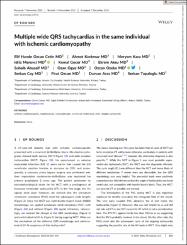| dc.contributor.author | Özcan Çetin, Elif Hande | |
| dc.contributor.author | Korkmaz, Ahmet | |
| dc.contributor.author | Kara, Meryem | |
| dc.contributor.author | Merovci, Idriz | |
| dc.contributor.author | Göçer, Kemal | |
| dc.contributor.author | Aksu, Ekrem | |
| dc.contributor.author | Abusaif, Suhaib | |
| dc.contributor.author | Oğuz, Ozan | |
| dc.contributor.author | Özeke, Özcan | |
| dc.contributor.author | Çay, Serkan | |
| dc.contributor.author | Özcan, Fırat | |
| dc.contributor.author | Aras, Dursun | |
| dc.contributor.author | Topaloğlu, Serkan | |
| dc.date.accessioned | 2023-02-23T06:41:29Z | |
| dc.date.available | 2023-02-23T06:41:29Z | |
| dc.date.issued | 2023 | en_US |
| dc.identifier.citation | Özcan Çetin, E. H., Korkmaz, A., Kara, M., Merovci, I., Göçer, K., Aksu, E. ... Topaloğlu, S. (2023). Multiple wide QRS tachycardias in the same individual with ischemic cardiomyopathy. Journal of Cardiovascular Electrophysiology, 34(1), 241-245. https://doi.org/10.1111/jce.15776 | en_US |
| dc.identifier.issn | 1045-3873 | |
| dc.identifier.issn | 1540-8167 | |
| dc.identifier.uri | https://doi.org/10.1111/jce.15776 | |
| dc.identifier.uri | https://hdl.handle.net/20.500.12511/10511 | |
| dc.description.abstract | A 67 ‐year‐old diabetic man with ischemic cardiomyopathy presented with a recurrent defibrillator shock. His electrocardiograms showed both narrow (NCT) Figure 1A) and wide complex tachycardias (WCT; Figure 1B). He experienced an anterior myocardial infarction (MI) 11 years earlier that caused the left ventricular ejection fraction to decrease to 25%, and subsequently, a coronary artery bypass surgery was performed and, then implantable cardioverter‐defibrillator was implanted for primary prophylaxis 2 years ago. The patient underwent to electrophysiological study for his WCT with a prediagnosis of incessant ventricular tachycardia (VT). In the first stage, the His signals were poor; however, we noticed that the premature ventricular complexes (PVC) reset the subsequent cycle lengths (Figure 2). Since the WCT was right bundle branch block (RBBB) morphology; we applied premature atrial complexes (PAC) with (Figure 3A) and without (Figure3B) septal refractory. Interestingly, we noticed the change in the QRS morphology (Figure 4) and ventriculoatrial (V‐A; Figure 5) during ongoing WCT. What are the mechanism of the different QRS morphology and ventriculoatrial (V‐A) responses of this tachycardia? | en_US |
| dc.language.iso | eng | en_US |
| dc.publisher | Wiley | en_US |
| dc.rights | info:eu-repo/semantics/embargoedAccess | en_US |
| dc.subject | Ischemic Cardiomyopathy | en_US |
| dc.subject | Nodofascicular | en_US |
| dc.subject | Nodoventricular | en_US |
| dc.subject | Ventricular Tachycardia | en_US |
| dc.subject | Wide Complex Tachycardia | en_US |
| dc.title | Multiple wide QRS tachycardias in the same individual with ischemic cardiomyopathy | en_US |
| dc.type | editorial | en_US |
| dc.relation.ispartof | Journal of Cardiovascular Electrophysiology | en_US |
| dc.department | İstanbul Medipol Üniversitesi, Tıp Fakültesi, Dahili Tıp Bilimleri Bölümü, Kardiyoloji Ana Bilim Dalı | en_US |
| dc.identifier.volume | 34 | en_US |
| dc.identifier.issue | 1 | en_US |
| dc.identifier.startpage | 241 | en_US |
| dc.identifier.endpage | 245 | en_US |
| dc.relation.publicationcategory | Diğer | en_US |
| dc.identifier.doi | 10.1111/jce.15776 | en_US |
| dc.institutionauthor | Aras, Dursun | |
| dc.identifier.wosquality | Q3 | en_US |
| dc.identifier.wos | 000898083900001 | en_US |
| dc.identifier.scopus | 2-s2.0-85144216112 | en_US |
| dc.identifier.pmid | 36511469 | en_US |
| dc.identifier.scopusquality | Q1 | en_US |


















